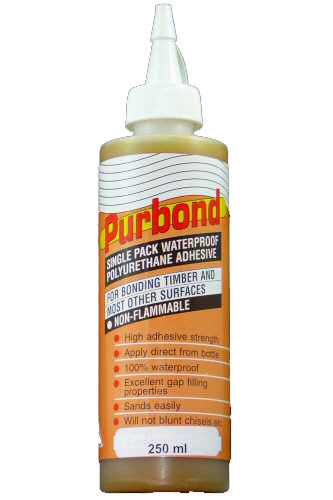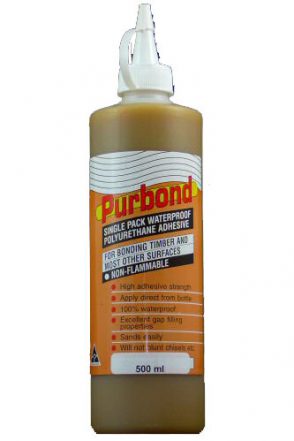Product Description
PURBOND TIPS
- Wear gloves or you will have black marks on your hands for a couple of days until it wears off. It will not come off with acetone or soap and water.
- Wear multiple pairs of disposable gloves; if you get PURBOND on them, peel the outer one off and keep working.
- Wipe the surfaces being joined with a damp cloth (water) and you will get a stronger cure. PURBOND is a moisture cure.
- Clamp joints tightly. If you don’t, the foaming action will push the sides apart and you will have a weak joint. Strength comes from the two faces being firmly squeezed together.
- You only need a little. 250ml per square metre. Just a bit more than if you were painting.
- Only apply PURBOND to one surface.
- Spread PURBOND over the whole surface.
- A plastic scraper works well (e.g. the side out of an icecream bucket etc.)
- DO NOT scrape off the squeeze out before it cures. This will only spread it further and make a bigger mess. It cleans off easily after it cures.
- Leave until dry and it cleans off easily with a knife, chisel, plane or sanding.
- You can use masking tape to prevent squeeze out getting onto unwanted places.
- Put cardboard or plastic on the floor so any excess will not stick if it drips on the floor.
- Freshly cut or sanded surfaces (less than six hours since cutting or sanding) result in the best joints. Even oily timbers such as Teak and Huon Pine.
- Timber burnished with blunt planer blades could give poor results. Sand cross grain with fresh, sharp medium (120 grit) sand paper. Clean metals, plastics and fibreglass with detergent/degreaser and wash off with water before gluing.
- Roughen plastics, fibreglass and metals with coarse (40-80 grit) sandpaper for best results.
- Avoid surface contamination with oils, greases, silicones, oil from your hands, the wax from some white or grey sandpapers etc. (Use yellow, red, green or black sandpaper, not white or grey.) They will act as a release agent.
- PURBOND will not bond polyethylene, polypropylene, Teflon, nylon or mylar.
- PURBOND bonds to other plastics, but may only have limited strength. Do a test piece to check the suitability.
- PURBOND is compatible with styrene foams and is a great way to bond them.
- The get maximum shelf life, store the bottle upside down.
- Throw away PVA, Cross linked PVA, Aquadhere etc. They might be cheaper but they just won’t perform like PURBOND. They creep, and despite some manufacturers claims, they are not waterproof, they gum up your tools and just don’t work all that well.
- Remember, no adhesive can glue absolutely anything to absolutely anything with absolute strength. For important items, do a test piece first and make sure it does what you want.
PURBOND
Gluing Timber, detailed instructions.
In order to use the glue, wood pieces should:
- Have a similar moisture content.
- Have a similar structure, density and mechanical behavior
- Be prepared at the same time
To prepare surfaces for gluing, make sure they are:
- Straight and even to obtain close contact between the work pieces
- Not “compressed” by machining (looks shiny)
- Able to absorb glue
- Free of oil, dust and other impurities
- Freshly prepared to limit oxidization of the natural resin/oil content of the wood
Moisture of Content of wood varies:
- Most kiln-dried wood is 8 to 12%
- The glue reaction in the glue line will accept moisture content in the range of 10 to 20 %
- When gluing open grain wood,wood with up to 25% moisture content may be acceptable
For wood with low moisture content (less than 10%), you must:
- Spray or wipe water onto the surface to be glued without soaking the wood
- Leave time for the moisture to distribute before applying the glue
- Apply glue soon after dampening an open grained wood
- Sand the moistened surface lightly before applying glue on closed grain wood or highdensity wood types in order to remove any oil/ resin emulsion and to create a larger gluable surface
- Leave some time after dampening a closed grain wood or high-density wood types to allow surplus water to evaporate
- Be careful, because by adding water, the open time may be reduced quite a bit
- Remember: moisture does not speed up the curing process but allows for a chemical reaction to take place
Clamping pressure:
- Varies according to wood structure and density, and may vary from job to job and from wood type to wood type
- Is usually 1 kg/cm2 to 7 kg/cm2 for softwoods
- Is usually 5 kg/cm2 to 15 kg/cm2 for hardwoods
- Clamping pressure should always be adjusted to secure close contact, and always be sufficient to secure minimum or no foam buildup in the glue line
- Clamping pressure must be distributed evenly over the glue line area
- Generally, clamping time has expired when the foam pressed out from the glue line feels dry and somewhat crisp
- Foam in a glue line has no structural strength whatsoever, and must not be considered as a gap filler
And finally
This type of adhesive has been used for structural wood working in Europe for the last 16 years or more and has been tracked by the research institutes and found to be quite sound over lengthy periods. It survives extensive boiling and is used in boat building.
No Video Content
Additional Information
| Weight | 0.3 kg |
|---|---|
| Dimensions | 6 x 20 x 6 mm |








